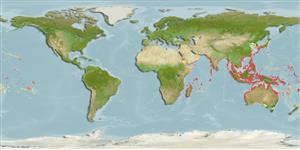Common names from other countries
Classification / Names / Names
Namen | Synonyme | Catalog of Fishes (gen., sp.) | ITIS | CoL | WoRMS
Environment: milieu / climate zone / depth range / distribution range
Ökologie
; brackwasser; tiefenbereich 0 - 20 m (Ref. 101198). Tropical, preferred 27°C (Ref. 107945); 46°N - 39°S, 26°E - 134°W (Ref. 106948)
Indo-Pacific.
Length at first maturity / Size / Gewicht / Alter
Maturity: Lm ?, range 2 - 2.1 cm Max length : 9.0 cm SHL Männchen/unbestimmt; (Ref. 348); common length : 6.0 cm SHL Männchen/unbestimmt; (Ref. 348); max. veröff. Alter: 12 Jahre (Ref. 126573)
Shell equivalve, thick and solid, ovate, strongly inflated, slightly longer than high and feebly inequilateral. Umbones strongly protruding, cardinal area rather large. About 18 radial ribs (15 to 20) with wide interstices at each valve; ribs stout and distinctly rugose, bearing regular, often rectangular nodules. Periostracum rather thin and smooth. Internal margins with strong crenulations corresponding with the external radial ribs. No byssal gape. Colour: outside of shell white under the yellowish brown periostracum. Inner side white, often tinged yellow towards the umbonal cavity.
This represents the most important commercial ark (Ref. 348).
Members of the class Bivalvia are mostly gonochoric, some are protandric hermaphrodites. Life cycle: Embryos develop into free-swimming trocophore larvae, succeeded by the bivalve veliger, resembling a miniature clam.
Poutiers, J.M. 1998. (Ref. 348)
IUCN Rote Liste Status (Ref. 130435: Version 2024-1)
CITES Status (Ref. 108899)
Not Evaluated
Not Evaluated
Bedrohung für Menschen
Harmless
Nutzung durch Menschen
Fischereien: kommerziell
FAO - Aquakultur: production; Fischereien: landings, Artbeschreibung | FishSource | Sea Around Us
Tools
Internet Quellen
Estimates based on models
Preferred temperature
(Ref.
115969): 21.8 - 29.3, mean 28.4 (based on 3701 cells).
Widerstandsfähigkeit
hoch, Verdopplung der Population dauert weniger als 15 Monate. (K=0.54-4.34; tm=0.6; tmax=12).
Prior r = 0.85, 95% CL = 0.56 - 1.28, Based on 2 data-limited stock assessments.
Verwundbarkeit
Low to moderate vulnerability (28 of 100).
